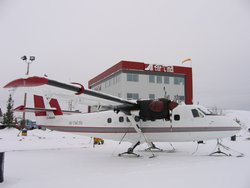De Havilland Canada DHC-6 Twin Otter
|
|
| De Havilland Twin Otter | ||
|---|---|---|
 Twin Otter on Skis | ||
| Description | ||
| Role | Transport | |
| Crew | 2 | |
| First Flight | may 20 1965 | |
| Entered Service | ||
| Manufacturer | de Havilland | |
| Dimensions | ||
| Length | 49 ft 6 in | 15.1 m |
| Wingspan | 65 ft 0 in | 19.8 m |
| Height | 19 ft 6 in | 5.9 m |
| Wing area | 420 ft² | 22.57 m² |
| Weights | ||
| Empty | 5850 lb | 2653 kg |
| Loaded | 10 500 lb | 4763 kg |
| Maximum takeoff | lb | kg |
| Capacity | ||
| Powerplant | ||
| Engines | 2 PT6A-20 turboprops | |
| Power | 578 shp | 431 kW |
| Performance | ||
| Maximum speed | 140 knot | 297 km/h |
| Ferry range | 771 miles | 1427 km |
| Service ceiling | ft | m |
| Rate of climb | ft/min | m/min |
| Wing loading | lb/ft² | kg/m² |
| Avionics | ||
The DHC-6 Twin Otter is the most successful aircraft program in Canada's history. Development of the aircraft began in 1964.
The first aircraft produced were the Series 100s. Later the 200s improved the STOL performance as well as adding a longer nose and reconfigured rear storage compartment. The 300s further increased performance by adding more powerful PT6A-27 engines.
Twin Otters can have their landing gear replaced with floats or skis, and are popular as bush planes in Alaska and northern Canada.
Additional Photos
IMG_0439-twin-otter.jpg
Twin_otter_used_for_parachuting.jpg
| Related content | |
|---|---|
| Related Development | |
| Similar Aircraft |
Antonov An-28 - Farchild Dornier 228 - GAF Nomad - Harbin Y-12 - IAI Arava - LET L-410 - Shorts SC.7 Skyvan |
| Designation Series | |
| Related Lists | |
|
Lists of Aircraft | Aircraft manufacturers | Aircraft engines | Aircraft engine manufacturers Airports | Airlines | Air forces | Aircraft weapons | Missiles | Timeline of aviation |
Template:Aero-stubno:de Havilland Canada DHC-6 Twin Otter id:DHC-6 de:de Havilland Canada DHC-6
